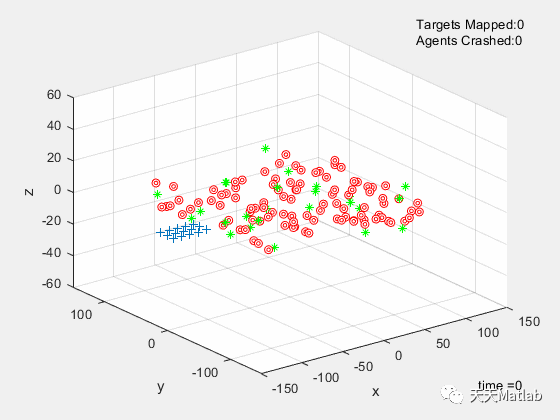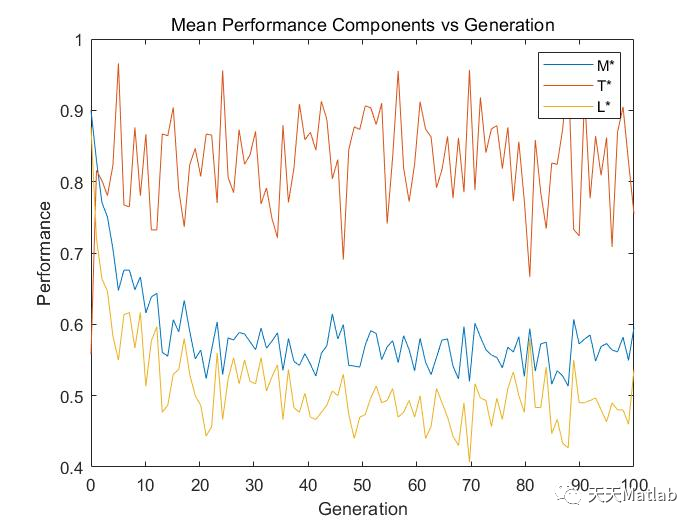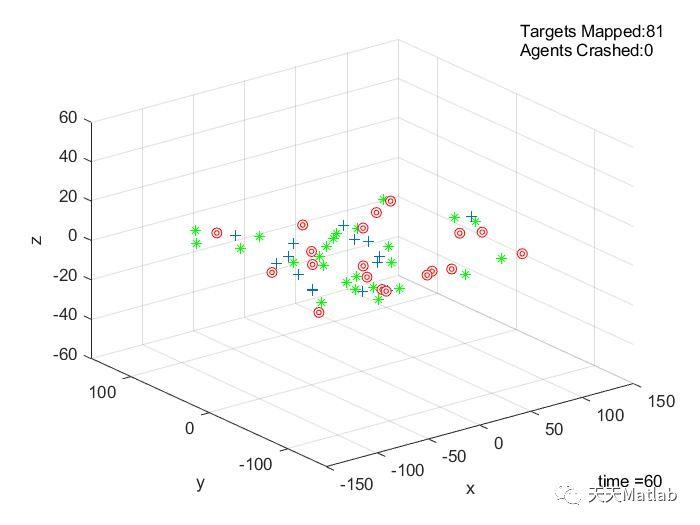1 内容介绍
现代社会的无人机成本造价低、不易损耗、轻巧灵便、易躲藏、能精确打击
目标这些特点,使其在一些高危任务中发挥了不可替代的作用[5]。无人机的用处主要有两种:民用和军事。在民用方面,我们可以运用无人机对一些可能出现隐患的事物进行监控,比如对震后灾区的地面勘探、森林火灾的检测、风暴中心的气象数据等。在 2014 索契奥运会上,无人机携带的摄像拍摄的画面更贴近运动员,画质更为清晰,2018 中国新年春晚上大量无人机组成的海豚造型惊艳了世界。在军事方面,我们可以运用无人机进行一些特殊任务的执行,比如对毒贩的监视工作,边境的巡防工作,无人机侦查、搜救、预警等。无人机的运用使我们在一些事情上实现了无人员伤亡。军事无人机是当今时代无人机技术的高水准体现。伴随着日益成熟的无人机技术,对航路规划的研究也愈加深入。航路规划的前提是在一定的约束条件下,然后寻求可飞行航路。对于无人机而言它自身的主要约束条件有:最大的载重量、可以上升的门限高度、空载时耗油量、起飞时承载的重量等,在飞行时要考虑地形存在的威胁和是否存在禁飞区等。相对国外研究,我国还没有比较成熟的航路规划体系,但是对航路规划的研究热情我国日益加强.飞行过程中有时会遇到一些突发事故,无人机在此时不能按照预先规划的航迹继续进行,需要无人机能够在当前的环境下动态的规划出一条满足要求的航路,也说明了航路规划的静态和实时动态规划相结合的算法是我们未来的一个研究趋势。
随着现代社会的不断发展,电子信息技术研究不断深入,无人机航路规划越
来越智能化。现代社会由于飞机的特殊性,其安全性一直是我们最为关心的话题,因为一旦发生一点点事故,往往伴随着生命的代价,所以在面对一些内部环境比较复杂的地方时,可以使用一些有着特殊功能的无人机,它们在无人的状态下可以将性能调整到最优,在执行任务的过程中不用担心其产生人员伤亡,而且无人机的活动区域比较广泛,不限单次使用,能够执行多种任务。现代战场上无人机的威力发挥很大程度上取决于航路规划的合理性。根据模型,航路规划通常会产生很多条满足条件的航路,而我们要做的就是快速、准确找到这些满足要求航路中的最优一条。随着无人机的硬件和软件技术的不断成熟,无人机航路规划技术也必将得到更好的发展和更广泛的应用.
2 仿真代码
%%%%%%%%%%%%%%%%%%%%%%%%%%%%%%%%%%%%%%%%%%%%%%%%%%%%%%%%%%%%%%%%%%%%%%%%%%%
% E150 Genetic Algorithm Evolution Visualizer
% Avery Rock, UC Berkeley Mechanical Engineering, avery_rock@berkeley.edu
% Written for E150, Fall 2019.
%%%%%%%%%%%%%%%%%%%%%%%%%%%%%%%%%%%%%%%%%%%%%%%%%%%%%%%%%%%%%%%%%%%%%%%%%%%
function familyTree(Orig, parents, pop)
%%
% Inputs:
% Orig -- the indices of a sorted GA generation from before sorting (see sort() documentation),
% parents -- the number of parents, required for interpreting source
% pop -- the number of performers to plot. Use pop >= parents.
% Returns:
% no variables, plots a representation of the evolution history to the current figure.
% The function automatically ignores generations where no rank changes
% occur among the parents OR there are any repeated indices (indicating
% incorrect data).
% Data visualization: This function can be used to visualize and interpret the performance of
% your GA iteration process. Gray lines represent "survival" with or
% without a rank change. Red lines represent breeding (e.g., a new string
% will be connected to its parents with red lines). New random strings have
% no connections. A surviving string will be represented with gray, a new
% string generated randomly will be a blue mark and a new string generated
% by breeding will be red.
% Performance interpretation: If your GA is working correctly, there should
% be lots of turnover (i.e., few generations where nothing happens),
% significant numbers of successful offspring and a moderate number of
% successful random strings. You can also spot stagnation (a parent
% surviving for many generations and continually producing offspring that
% stay in the top ranks).
%%
Orig2 = Orig(:, 1:pop); % trim source to just relevant entries.
row = 0; changes = []; % initialize variables for determining relevant generations
children = parents; % assume nearest-neighbor with two children
rando = zeros(0, 2); inc = zeros(0, 2); kid = zeros(0, 2); % intialize empty storage arrays
G = size(Orig, 1); % total number of generations.
pts = 25; % number of points to plot in connections
c1 = [.6 .6 .6]; c2 = [1 .6 .6]; % line colors for surviving connections and children
lw = 1.5; % connection line weight
mw = 1.5; % marker line weight
incx = zeros(pts, 2); incy = zeros(pts, 2); % empty arrays for connecting line coordinates.
kidx = zeros(pts, 2); kidy = zeros(pts, 2);
for g = 1:G % for every generation
if ~isequal(Orig2(g, 1:parents), 1:parents) && length(unique(Orig2(g, :))) == pop % if a change in survivors and valid data
row = row + 1; % row on which to plot current state - counts relevant generations
x1 = row - 1; x2 = row; % start and end points of connections
changes = [changes; g]; % record that a change occured in this generation
for i = 1:pop
s = Orig2(g, i); y2 = i;
if s == i && i <= parents && g > 1 % if the entry is a surviving parent who has not moved
y1 = i;
[xx, yy] = mySpline([x1 x2], [y1 y2], pts);
incx = [incx, xx]; incy = [incy, yy];
inc = [inc; [x2, y2]];
elseif s <= parents && g > 1% if the entry is a surviving parent who has been moved down
y1 = s;
[xx, yy] = mySpline([x1 x2], [y1 y2], pts);
incx = [incx, xx]; incy = [incy, yy];
inc = [inc; [x2, y2]];
elseif s <= parents + children && g > 1 % if the entry is a child
for n = 2:2:children
if s <= parents + n
y11 = n - 1; y12 = n;
[xx1, yy1] = mySpline([x1, x2], [y11, y2], pts);
[xx2, yy2] = mySpline([x1, x2], [y12, y2], pts);
kidx = [kidx, xx1, xx2]; kidy = [kidy, yy1, yy2];
kid = [kid; [x2, y2]];
break
end
end
else % if it's a new random addition.
rando = [rando; [x2, y2]];
end
end
end
end
p1 = plot(incx, incy, '-', 'Color', c1, 'LineWidth', 1.5); hold on
p2 = plot(kidx, kidy, '-', 'Color', c2, 'LineWidth', 1.5); hold on
p3 = plot(rando(:, 1), rando(:, 2), 's', 'MarkerEdgeColor', [.2 .4 .9], 'MarkerFaceColor', [.6 .6 1], 'MarkerSize', 10, 'LineWidth', mw); hold on % plot random
p4 = plot(inc(:, 1), inc(:, 2), 's', 'MarkerEdgeColor', [.3 .3 .3], 'MarkerFaceColor', [.6 .6 .6], 'MarkerSize', 10, 'LineWidth', mw); hold on % plot survival
p5 = plot(kid(:, 1), kid(:, 2), 's', 'MarkerEdgeColor', [.9 .3 .3], 'MarkerFaceColor', [1 .6 .6], 'MarkerSize', 10, 'LineWidth', mw); % plot children
h = [p3, p4, p5];
legend(h, "Random", "Incumbent", "Child")
xlabels = {};
for i = 1:numel(changes)
xlabels{i} = num2str(changes(i));
end
ylabels = {};
for j = 1:pop
ylabels{j} = num2str(j);
end
title("Family Tree");
set(gca, 'xtick', [1:row]); set(gca,'ytick', [1:pop]);
set(gca,'xticklabel', xlabels); set(gca,'yticklabel', ylabels);
xlabel("generation"); ylabel("Rank");
axis([0 row + 1 0 pop + 1]); view([90, 90])
end
function [xx, yy] = mySpline(x, y, pts)
% produces clamped splines between two points
% Inputs:
% x -- 2-value vector containing the x coordinates of the end points
% y -- 2-value vector containing the y coordinates of the end points
% pts -- the number of total points to plot (ends plus intermediates)
% Returns:
% xx -- array of x coordinates to plot
% yy -- array of y coordinates to plot
cs = spline(x, [0 y 0]);
xx = linspace(x(1), x(2), pts)';
yy = ppval(cs,xx);
end
UAV swarms have numerous applications in our modern world. They can facilitate mapping, observing, and overseeing large areas with ease. It is necessary for these agents to autonomously navigate potentially dangerous terrain and airspace in order to log information about areas. In this project, we simulate the motion of a swarm of drones, and their interaction with obstacles, and targets.
The goal of this project is to optimize this simulation using a Genetic Algorithm to maximize the number of targets mapped, minimize the number of crashed drones, and minimize the amount of time used in the simulation. To do this, we will use 15 design parameters to determine the dynamics and kinematics of each drone, using Forward Euler time discretization to update drone positions.
A Genetic Algorithm will be used to train this swarm of drones by generating random strings of design parameters, and breeding new strings to find the optimal string for this simulation.
In this paper, I will present relevant background information, and equations to describe the simulation. I will also describe the process by which I go about optimizing the Genetic Algorithm. Finally, I present the outcome of the simulation and Genetic Algorithm, and discuss the relevance of my results.
3 运行结果





4 参考文献
[1]杨军, 王道波, 渠尊尊,等. 基于元胞遗传算法的多无人机编队集结路径规划[J]. 机械与电子, 2018, 36(1):5.
[2]黄书召, 田军委, 乔路,等. 基于改进遗传算法的无人机路径规划[J]. 2021.
[3]邵壮. 多无人机编队路径规划与队形控制技术研究[D]. 西北工业大学.
博主简介:擅长智能优化算法、神经网络预测、信号处理、元胞自动机、图像处理、路径规划、无人机等多种领域的Matlab仿真,相关matlab代码问题可私信交流。
部分理论引用网络文献,若有侵权联系博主删除。
本文内容由网友自发贡献,版权归原作者所有,本站不承担相应法律责任。如您发现有涉嫌抄袭侵权的内容,请联系:hwhale#tublm.com(使用前将#替换为@)